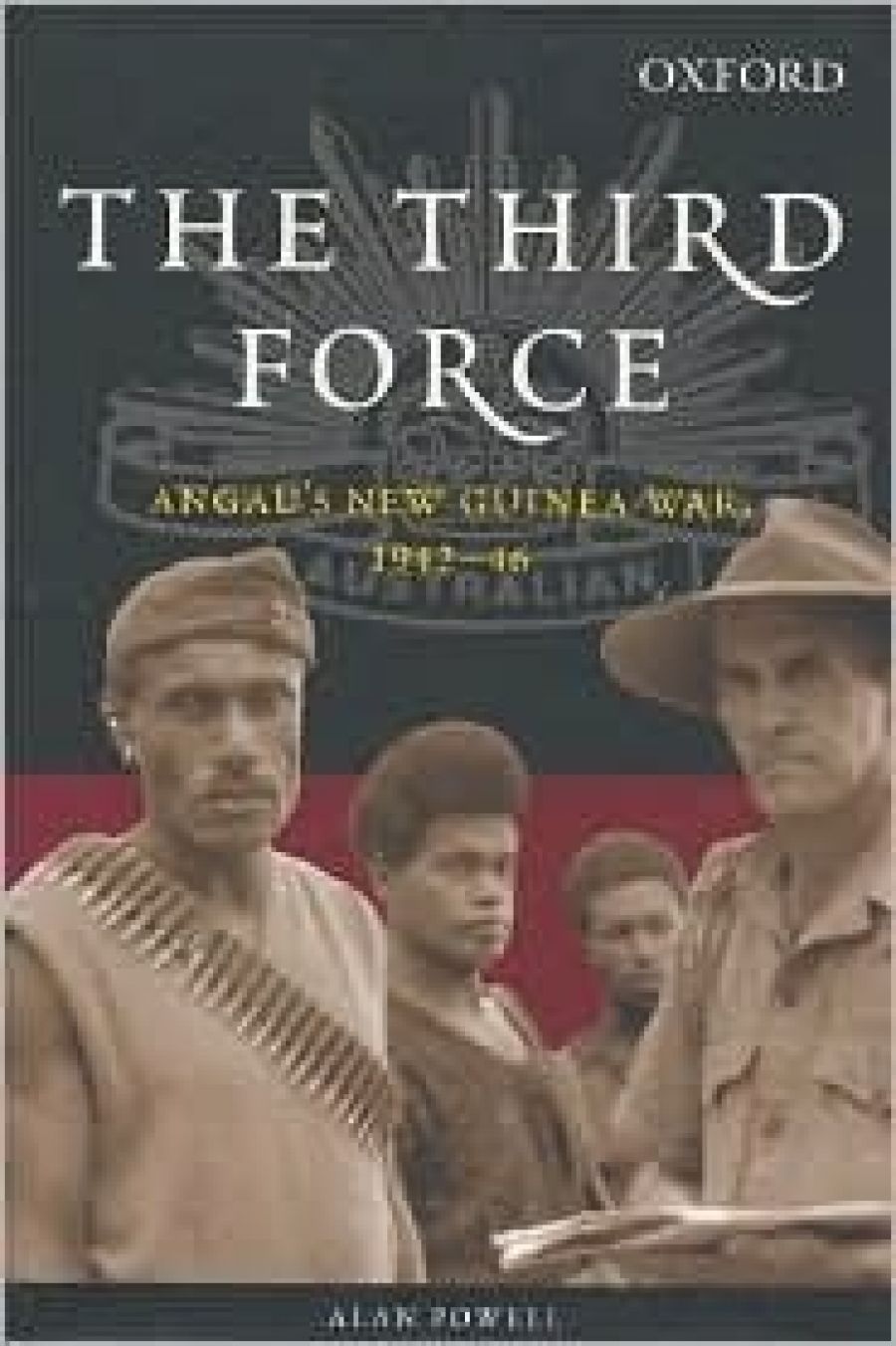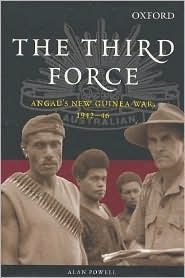
- Free Article: No
- Contents Category: Military History
- Review Article: Yes
- Article Title: Only One Masta
- Online Only: No
- Custom Highlight Text:
It is one of the paradoxes of our history that the battle for New Guinea between 1942 and 1945 – so much harder but so much more successful than Gallipoli – is so little studied or understood. It has made such a relatively shallow impression on our national consciousness, compared with Australia’s 1915 expedition to Turkey. The New Guinea campaign was, if not unique, certainly one of the most extraordinary conducted by any belligerents during World War II because, as Alan Powell notes, it ‘relied upon the muscle and sinew and bushcraft of the local people for success’.
- Book 1 Title: The Third Force
- Book 1 Subtitle: Angau’s New Guinea War 1942-46
- Book 1 Biblio: Oxford University Press, $55 hb, 292 pp
- Book 1 Cover Small (400 x 600):

- Book 1 Cover (800 x 1200):

For most Australians, the single strong image we have of the New Guinea war is of ‘fuzzy-wuzzy angels’ assisting wounded Australian troops on the Kokoda Trail. Powell’s story concerns the Australian New Guinea Administrative Unit (ANGAU), effectively the military government of PNG following the collapse of the civil administration after the Japanese invasion in 1942. But for the Papuans and New Guineans who assisted and often fought beside the Australians and Americans opposed to the Japanese, there could have been no effective resistance. As a commentator on one of Damien Parer’s films of the campaign stated bluntly (and with forthright political incorrectness), ‘no boongs, no battle’. But for ANGAU, there would have been no ‘fuzzy-wuzzy angels’.
The rosy image of black and white men bonding together on the Kokoda Trail places a gloss over a complex and often harsh reality. Powell’s book forms part of the joint OUP/Australian Army History Unit series. The AAHU’s objective is not only to record the army’s history but to maintain the army’s heritage. To its credit, the army did not require Professor Powell to turn out a puff piece. While Powell’s admiration of ANGAU’s extraordinary achievements is manifest, he does not pull punches in examining the dark side of the army’s administration of New Guinea during the war. This makes The Third Force a profoundly valuable study.
ANGAU came into being in February 1942 following the collapse of law and order in Port Moresby and, with it, the civil administration, following the Japanese attack. The staff of the civil administration were conscripted, together with all expatriate men of military age. District Officers were commissioned into the army together with other expatriates and recruits from Australia. ANGAU’s immediate function, once the Japanese invasion gained momentum on the northern coast of New Guinea, was effectively that of a press-gang. It remained so throughout the war. While much of ANGAU’s work was benevolent, especially the provision of medical treatment and hospitals for the native peoples, its principal task was to conscript and provide native labourers and support for the Allied armies. Thus, with the Australians and Americans, the indispensable PNG labourers, guides, intelligence operatives, coast watchers, stretcher-bearers, carriers, police and nurses (plus the soldiers of the Pacific Islands Regiment) became the ‘Third Force’ that defeated the Japanese.
The cost to the peoples of PNG was high, and many of them regarded ANGAU as an oppressive force. While PNG war casualties were significant but not enormous, the economic impact of removing virtually all able-bodied men from villages living at subsistence level is incalculable. The suffering of the men pressed into service was magnified not only by their sense of loss but by their fears for the safety of their families and communities at home, sometimes hundreds of miles away by walking track. Highlanders became infected with malaria and other diseases unknown in their home districts. Overseers of Native Labour Companies were sometime harsh. Some ANGAU officers resorted to corporal punishment with the natural confidence of public school prefects.
At least some New Guineans initially regarded the Japanese as liberators. The comfortable image of loyal ‘angels’ on the Kokoda Trail is therefore a misleading one, and Powell picks through the intricacies of the sensitive topic of ‘loyalty’. It seems that ANGAU officers, with honourable exceptions, were generally regarded with fear and respect by the locals, who regarded them as a continuation of the pre-war régime. Brave and resourceful the ANGAU officers were, but they had no doubts about who was ‘masta’.
What seems to have attracted the heartfelt loyalty of many Papuans and New Guineans was the attitude of the Australian frontline troops. One young New Guinean man described how he had run to a slit trench in Wau during an air raid to find it occupied by AIF troops. They welcomed him. The ‘English’ (the pre-war administrators), he said, would have thrown him out. An anthropologist noted that another New Guinean’s experience of simply eating a tin of bully-beef with some Australian soldiers ‘denoted a recognition of equality entirely foreign to previous experience’. Nonetheless, this is an incomplete answer to the question, and Powell remains, as must the reader, puzzled by the profundity of the loyalty of the native peoples of PNG to Australia, which reached ‘far beyond the bounds of pragmatism’.
Unattractive as some aspects of ANGAU’s régime may have been, the battle could not have been won without it. But it is the native peoples who emerge from this fascinating and powerful account as the true heroes of the campaign. What gives the book its particular authority is that Powell articulates the stories of individual men who served within ANGAU’s ranks, and their often extraordinary feats. He accurately sums up their contribution: ‘ANGAU’s men, black and white, were the essential force behind the Allied war machine in New Guinea; a symbiosis that carried the seeds of victory.’ Powell’s fine book is a worthy tribute to those strong, brave men of PNG.


Comments powered by CComment